- Pregnancy Dermatoses
- Goals and Objectives
- Pregnancy Dermatoses
- Case One
- Case One: History
- Case One: Skin Exam
- Diagnosis: Pemphigoid gestationis
- Pemphigoid gestationis
- Pemphigoid gestationis: Treatment
- Complications
- Prognosis
- Case Two
- Case Two: History
- Case Two: Skin Exam
- PUPPP
- Pathogenesis
- PUPPP: Clinical Findings
- Evaluation
- PUPPP: Prognosis
- PUPPP: Treatment
- PG versus PUPPP
- Case Three
- Case Three: History
- Intrahepatic Cholestasis of Pregnancy
- Intrahepatic Cholestasis of Pregnancy
- Evaluation
- ICP: Complications
- ICP: Treatment
- ICP: Therapeutic Options
- Case Four
- Case Four: History
- Case Four: Skin Exam
- Case Four, Question 1
- Case Four, Question 1
- Atopic Eruption of Pregnancy
- Diagnosis: Atopic Eruption of Pregnancy
- Atopic Eruption of Pregnancy
- Case Four, Question 2
- Case Four, Question 2
- AEP: Treatment
- Going back to our cases:
- Review Question 1
- Review Question 2
- Review Question 2
Pregnancy Dermatoses
Dr Sami Aldaham
Goals and Objectives
- By completing this module, the learner will be able to:
- Identify and describe the morphology of specific dermatoses of pregnancy
- List which dermatoses of pregnancy carry risks for the mother and the fetus
- Explain basic principles in the diagnosis and treatment of specific pregnancy dermatoses
Pregnancy Dermatoses
- There are four specific dermatoses of pregnancy, according to the most recent proposed classification:
- Pemphigoid gestationis
- Pruritic urticarial papules and plaques of pregnancy (PUPPP)
- Atopic eruption of pregnancy
- Intrahepatic cholestasis of pregnancy
Each pregnancy dermatosis is distinct and carries different risks for the mother and the fetus.
A distinction must be made between dermatological diseases that happen to occur while the patient is pregnant versus specific dermatoses that occur only during pregnancy.
Pregnant patients with dermatologic conditions requiring treatment should be co-managed with an obstetrician.
Case One
Safa
Case One: History
- Safa is a 34-year-old woman who presents with a one-month history of a skin eruption.
- She is 31 weeks pregnant with her first child.
- She says that she first noticed the eruption after she swam in a lake.
- The rash started on her abdomen and rapidly spread to her arms and legs.
- The eruption is very pruritic and sometimes forms blisters.
- She tried applying calamine lotion, which provided temporary relief. The lesions, however, continue to progress.
- She is otherwise healthy and is on prenatal multivitamins.
Case One: Skin Exam
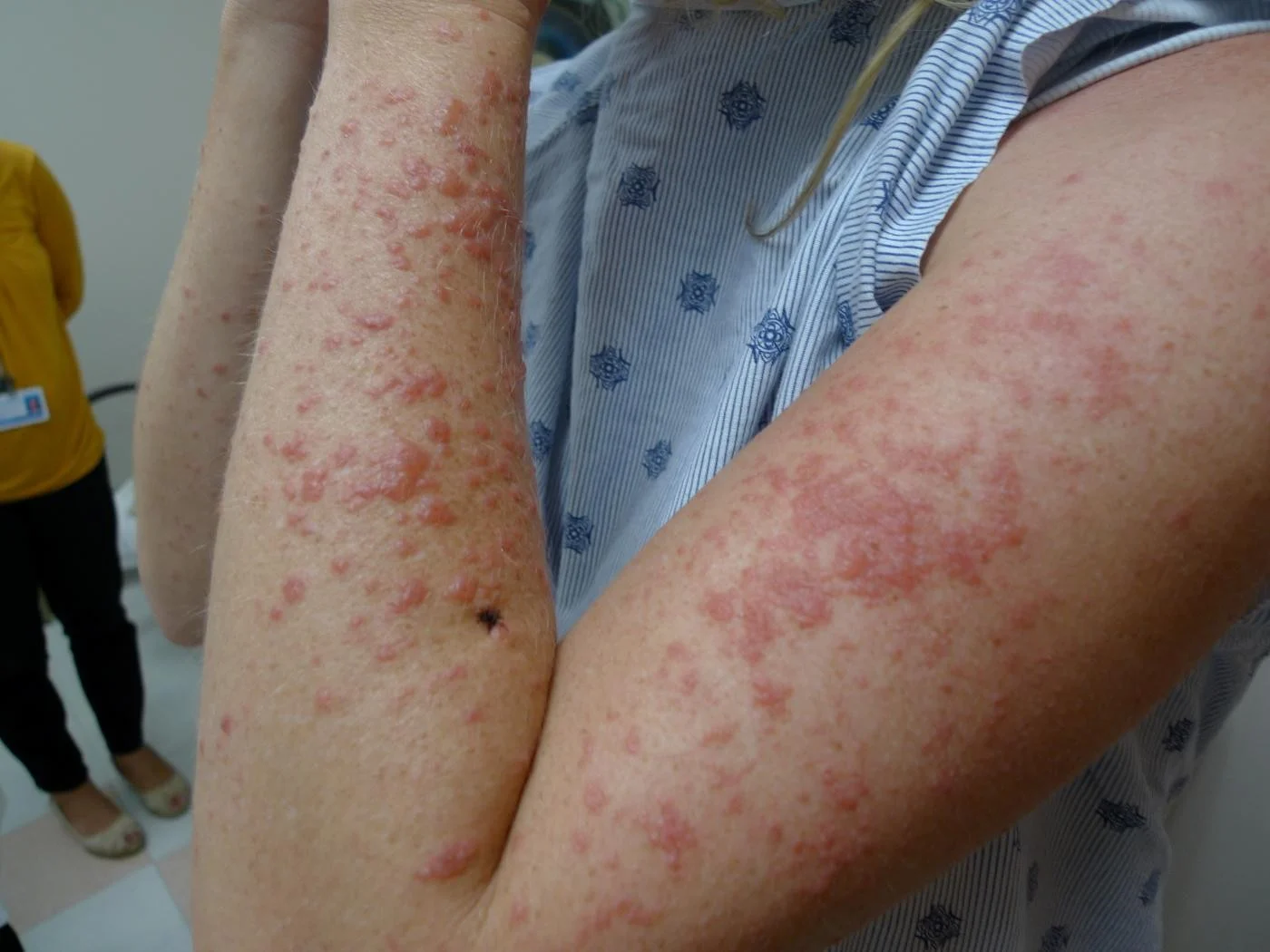
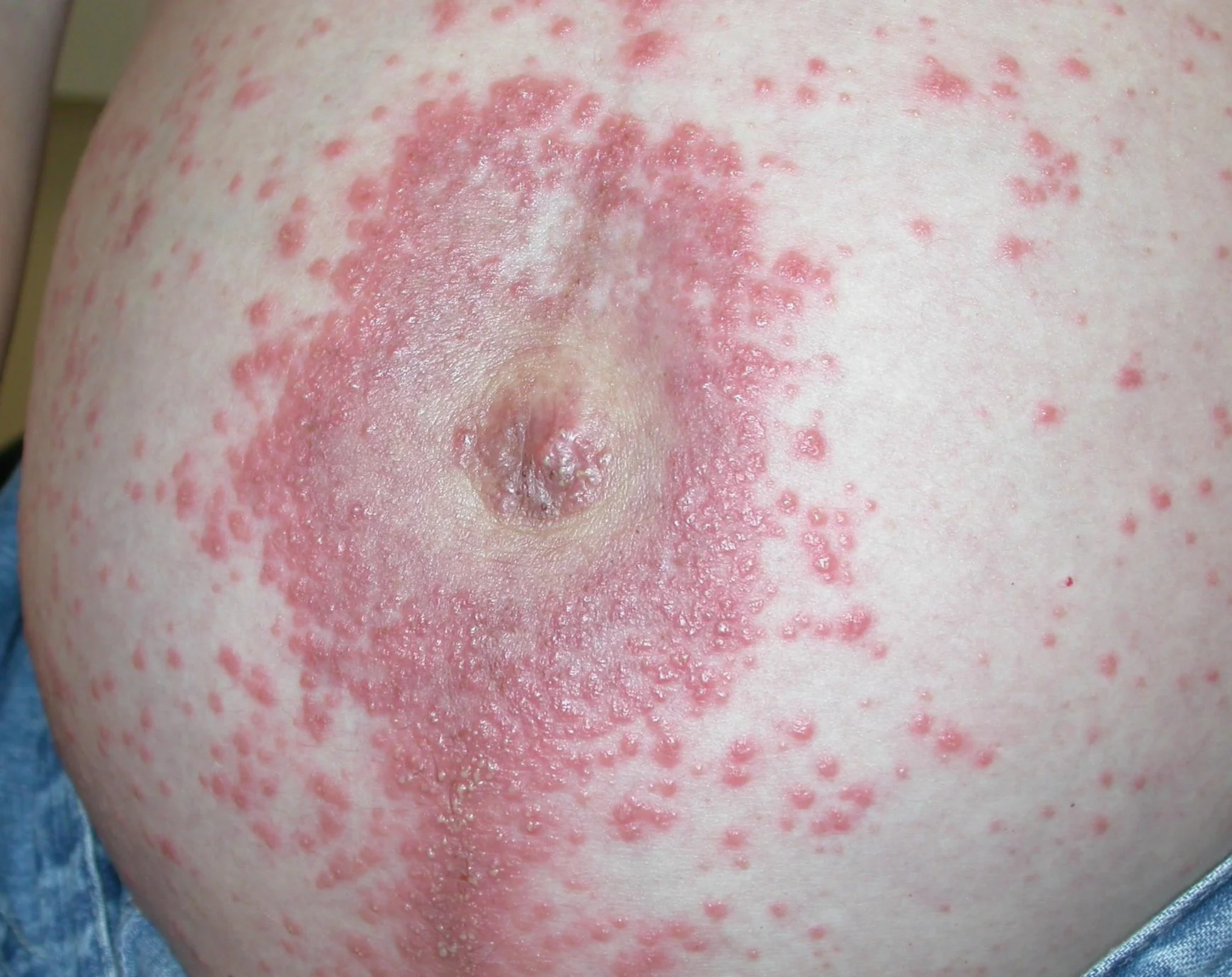
Diagnosis: Pemphigoid gestationis
- Autoimmune blistering disease
- Incidence: 1 in 10,000-50,000 pregnancies
- Starts in 2nd or 3rd trimester (mean onset = 21 weeks)
- Presents as pruritic papules and vesicles/bullae
- Involves the umbilicus in fifty percent of cases
Pemphigoid gestationis
Histopathology often helps with the diagnosis. Findings include a subepidermal blister with eosinophils.
Immunofluorescence provides a definitive diagnosis with findings of a linear band of C3 +/- IgG at the basement membrane zone.
Pemphigoid gestationis: Treatment
1- Topical steroids can be helpful in mild disease.
2- With widespread disease, patients will often benefit from oral steroids, which are safe to use in pregnancy (category B drug).
Complications
- Preterm delivery
- Small-for-gestational age infants
- Blisters (10% risk) in the neonate secondary to maternal transfer of antibodies.
Prognosis
1- There is often a flare at the time of delivery (75% of cases). 2- Pemphigoid gestationis can start postpartum (20% of cases). 3- Recurrence with menses or OCP use has been reported but is rare.
COPYRIGHT PCDS.ORG.UK
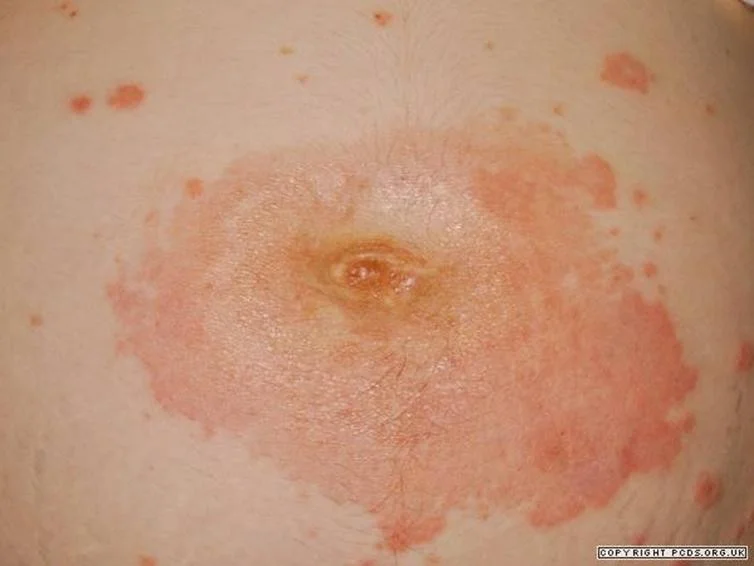
Case Two
Rasha
Case Two: History
Rasha is a healthy 28-year-old primigravid.
She is in her 34th week of gestation.
Two weeks ago, she developed a pruritic eruption on her abdomen and thighs.
Case Two: Skin Exam
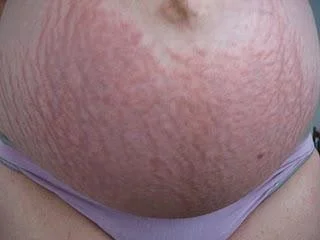
PUPPP
This is a case of pruritic urticarial papules and plaques of pregnancy (PUPPP)
Common dermatosis of pregnancy Also known as Polymorphic eruption of pregnancy(PEP)
Incidence: 1 in 300 pregnancies
Onset during 3rd trimester (mean = 35 weeks)
Predominantly affects primigravids
Pathogenesis
The pathogenesis is unclear.
- One leading theory is abdominal wall distention, especially since PUPPP is more common in primigravids and multiple gestation pregnancies.
- Hormonal, immunological, factors may also play a role.
PUPPP: Clinical Findings
1-Typical lesions are erythematous urticarial papules surrounded by a pale halo.
2- In the vast majority of cases, the eruption starts within the abdominal striae (with periumbilical sparing) and progresses from there.
3- Less commonly, PUPPP can present with blisters and the umbilicus may be involved
Evaluation
The diagnosis is made based on the history and the clinical picture.
A biopsy is rarely helpful in diagnosing PUPPP.
It does, however, rule out pemphigoid gestationis, which is an important differential diagnosis.
- If the patient has an atypical presentation, or if you are concerned about pemphigoid gestationis, consider referral to a dermatologist or a skin biopsy with immunofluorescence.
- A skin biopsy of PUPPP would reveal non-specific findings



PUPPP: Prognosis
1- Has not been shown to have increased maternal or fetal risks 2- Excellent prognosis 3- Generally resolves within days postpartum 4- No reports of recurrence postpartum, with menses, or with use of oral contraceptives
PUPPP: Treatment
Therapeutic options are aimed at symptomatic relief:
- Topical steroids
- Oral prednisone
- Non-sedating oral antihistamines




COPYRIGHT PCDS.ORG.UK
A
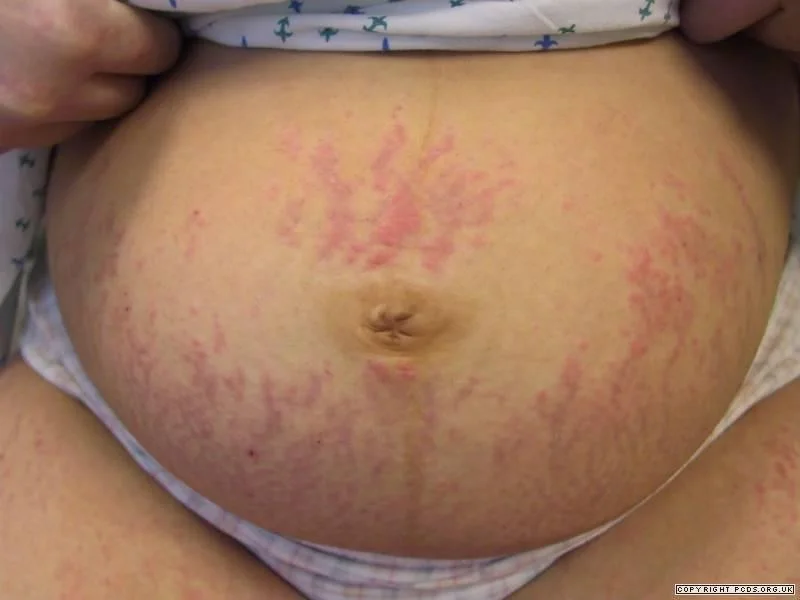

PG versus PUPPP
| Pemphigoid gestationis | PUPPP | |
|---|---|---|
| ONSET | 2nd or 3rd trimester | 3rd trimester |
| BLISTERS | common | rare |
| BIOPSY/IF | diagnostic | non-diagnostic |
| FETAL RISKS | SGA, preterm, blisters | none |
| RECURRENCE | yes | no |
Case Three
Wala
Case Three: History
- Wala presents with intense, non-remitting pruritus without skin lesions.
- She is G3P2. Both previous pregnancies were uncomplicated. She is in her 30th week of gestation.
- She says the itch is worse after a hot shower.
- She is healthy, except for a history of eczema as a child and well-controlled hypothyroidism.
Intrahepatic Cholestasis of Pregnancy
- Accounts for 20% of obstetric jaundice
- Presents with
- Generalized pruritus +/- jaundice
- Absence of primary lesions
- Biochemical abnormalities consistent with cholestasis
- No history of exposure to hepatitis or hepatotoxic drugs
Intrahepatic Cholestasis of Pregnancy
Pathophysiology
- Thought to be due to increased levels of estrogen
- Estrogen Effects
- Promotes cholestasis
- Inhibits reuptake of bile acids into hepatocytes
- Inhibits bile transport proteins
Evaluation
elevation of
- Raised bilirubin
- Raised transaminases
- Raised alkaline phosphatase
- the hallmark of ICP is elevation of serum bile acids.




ICP: Complications
For the mother, risks associated with ICP include
1- Bleeding
2- Intestinal malabsorption
3- Cholelithiasis
- For the fetus risks include
Prematurity
Fetal distress
Death.
ICP: Treatment
- Although ICP resolves after delivery, treatment is indicated.
- The goal of treatment is to decrease circulating bile acids.
- Vitamin K supplementation plays a role in management if bleeding parameters become abnormal.
ICP: Therapeutic Options
The goal of treatment is to reduce symptoms and to prevent maternal and fetal complications.
-
early induction of labor, commonly at 37 to 38 weeks.
-
Ursodeoxycholic acid
-
When cholestasis is severe, delivery is considered earlier if fetal lung maturity is established.
-
Considered 1st- line treatment
Case Four
Sayda
Case Four: History
- Sayda is a 25-year-old woman who comes in for an itchy eruption that began two weeks ago.
- She is 20 weeks pregnant with her second child. Her previous pregnancy was unremarkable.
- She is healthy and has no history of atopy.
Case Four: Skin Exam
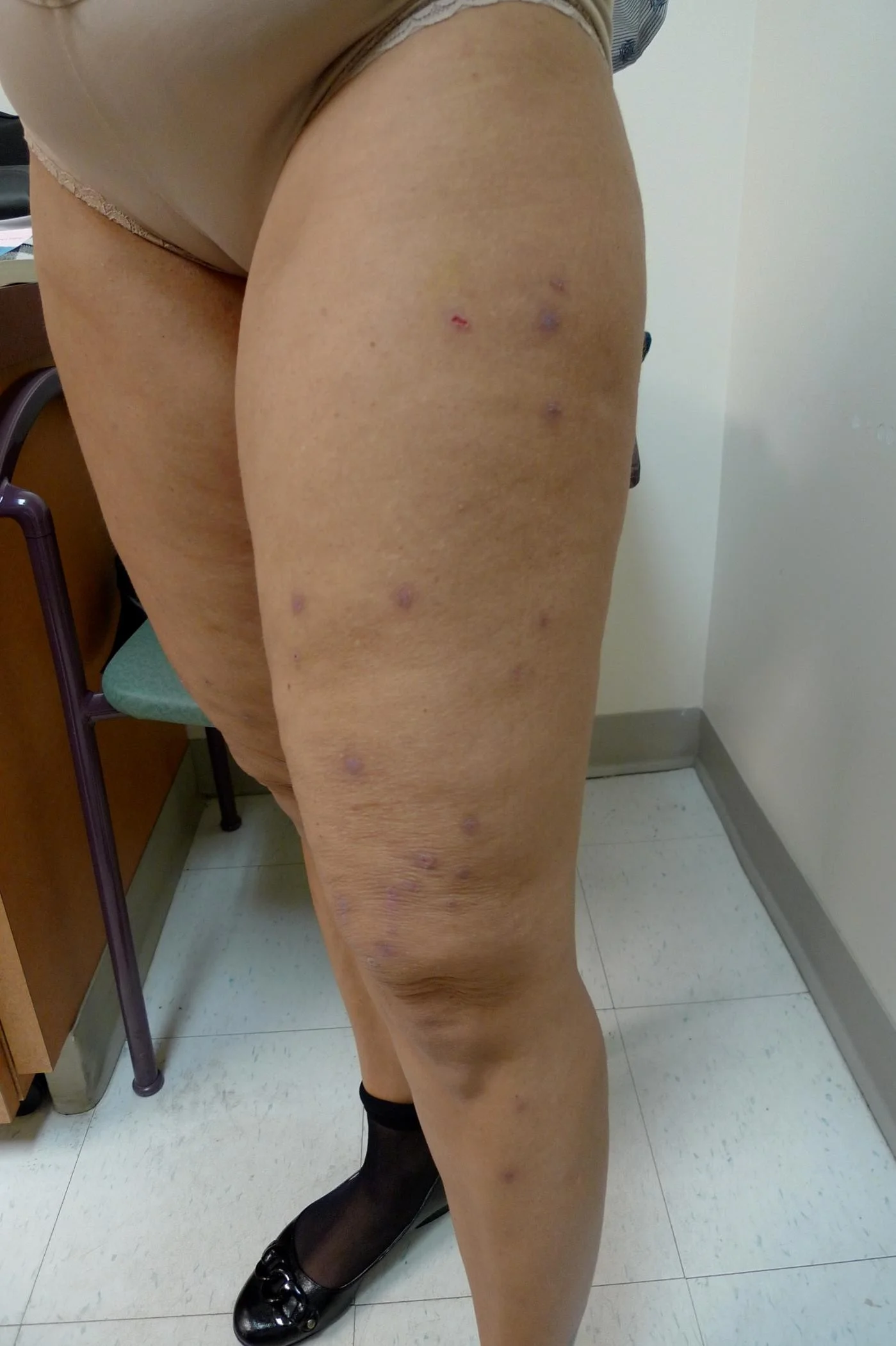
Case Four, Question 1
- The best way to describe her lesions is: a. deep-seated nodules over the legs b. lichenified papules over the legs, some of which are excoriated c. multiple ill-defined scaly plaques d. well-demarcated, scaly macules scattered over the extremities
Case Four, Question 1
Answer: b
- The best way to describe her lesions is: a. deep-seated nodules over the legs b. lichenified papules over the legs, some of which are excoriated c. multiple ill-defined scaly plaques d. well-demarcated, scaly macules scattered over the extremities
Atopic Eruption of Pregnancy
Atopic eruption of pregnancy is a term that encompasses other pruritic inflammatory dermatoses which appear or worsen during pregnancy:
- Atopic dermatitis in pregnancy
- Prurigo of pregnancy (Besnier) -Prurigo = intensely itchy papules
- Pruritic folliculitis of pregnancy
- Pruritic folliculitis = itchy inflammation around the hair follicle
Diagnosis: Atopic Eruption of Pregnancy
- This is an example of an atopic eruption of pregnancy (prurigo type).
- Atopic eruption of pregnancy (AEP):
- Eczematous in 2/3 and prurigo type in 1/3
- Starts earlier in pregnancy (mean=18 weeks)
- 80% of patients have a previous history of atopic dermatitis while 20% do not
Atopic Eruption of Pregnancy
- AEP is a clinical diagnosis.
- Histopathology is non-specific.
- Immunofluorescence is negative.
Case Four, Question 2
- Sayda is worried that her baby will be affected by her disease. What do you tell her? a. She will need to be monitored as a high-risk pregnancy. b. There have been reports of fetal distress in patients with AEP. c. There is a risk of small-for-gestational age births in AEP. d. There is no need to worry. Fetal distress is not increased in patients with AEP.
Case Four, Question 2
Answer: d
- Sayda is worried that her baby will be affected by her disease. What do you tell her? a. She will need to be monitored as a high-risk pregnancy. b. There have been reports of fetal distress in patients with AEP. c. There is a risk of small-for-gestational age births in AEP. d. There is no need to worry. Fetal distress is not increased in patients with AEP.
AEP: Treatment
- AEP is a benign disease and does not carry increased maternal or fetal risks.
- Treatment is largely dependent on controlling the eruption with topical steroids.
- Oral steroids can be used in recalcitrant cases.
- If the eruption does not respond to topical steroids, referral to dermatology is recommended.
- The eruption may persist after pregnancy as a chronic dermatitis.
Going back to our cases:
Review Question 1
- Which disease is caused by specific antibodies? a. Atopic eruption of pregnancy b. Intrahepatic cholestasis of pregnancy c. Pemphigoid gestationis d. Pruritic urticarial papules and plaques of pregnancy
Review Question 1
Answer: c
- Which disease is caused by specific antibodies? a. Atopic eruption of pregnancy b. Intrahepatic cholestasis of pregnancy c. Pemphigoid gestationis d. Pruritic urticarial papules and plaques of pregnancy
Review Question 2
- Which of the following is true?
- Atopic eruption of pregnancy only occurs in patients with a history of atopic dermatitis.
- Intrahepatic cholestasis of pregnancy can have serious complications for both mother and child.
- PUPPP and pemphigoid gestationis have identical findings on immunofluorescence.
- There is a high risk of blisters in the neonate in pemphigoid gestationis.
Review Question 2
Answer: b
- Which of the following is true? a. Atopic eruption of pregnancy only occurs in patients with a history of atopic dermatitis. b. Intrahepatic cholestasis of pregnancy can have serious complications for both mother and child. c. PUPPP and pemphigoid gestationis have identical findings on immunofluorescence. d. There is a high risk of blisters in the neonate in pemphigoid gestationis.